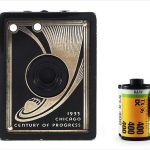Ansco Century of Progress Specifications
| Manufacturer: | Agfa-Ansco |
| Origin: | USA |
| Made in: | Binghamton, NY, USA |
| Introduced: | 1933 |
| Type: | Box, Viewfinder |
| Format: | 120 Film |
| Dimensions: | 8.3 x 10.7 x 13.7 cm |
Ansco Century of Progress Overview
The Ansco Century of Progress is a commemorative version of the Ansco No. 2 Box camera made by Agfa-Ansco to be sold at the 1933 “Century of Progress” World’s Fair which took place in Chicago, USA. There were several branded cameras available at the 1933 World’s Fair including one based on the Kodak No. 2 Brownie as well as the cheap and cheerful “Yen Camera” from Japan.
With the only difference between a run of the mill Ansco No. 2 Box and this 1933 World’s Fair variant being the design on the front plate, the Century of Progress is fairly primitive. Like most box cameras of the era, there are two right-angle viewfinders which allow for portrait and landscape orientation built into the top and user’s right hand side, respectively. All of the controls are on the user’s right hand side: a film advance knob, a metal tab that can be pulled out to enable the camera’s “time” speed (the exposure starts with the first trip of the shutter button and then ends with the second), an aperture selector with three options (f/8, f/8 with yellow filter, and f/11), and the shutter button itself which trips the camera’s rotary shutter no matter which direction it is pushed. A leather handle is typically found on the top (missing on mine) next to the film door latch. A red window through which you can keep track film usage is located is on the back of the camera.
As a Chicagoan, I had my eye on a 1933 World’s Fair camera for what felt like an eternity before I picked up a branded yen camera and then eventually found this Ansco Century of Progress. Now they sit together on the same shelf just above a 1939 New York World’s Fair branded Kodak Baby Brownie. The Ansco Century of Progress is not the rarest, most expensive, or most technologically complex camera in my collection but it’s got a special place in my heart anyway.
Find your very own Ansco Century of Progress on eBay.
McKeown, James M. and Joan C. McKeown’s Price Guide to Antique and Classic Cameras, 2001-2002. (Grantsburg, WI, USA: Centennial Photo Service, 2001), p 36, 50-51, 325, 708.


















